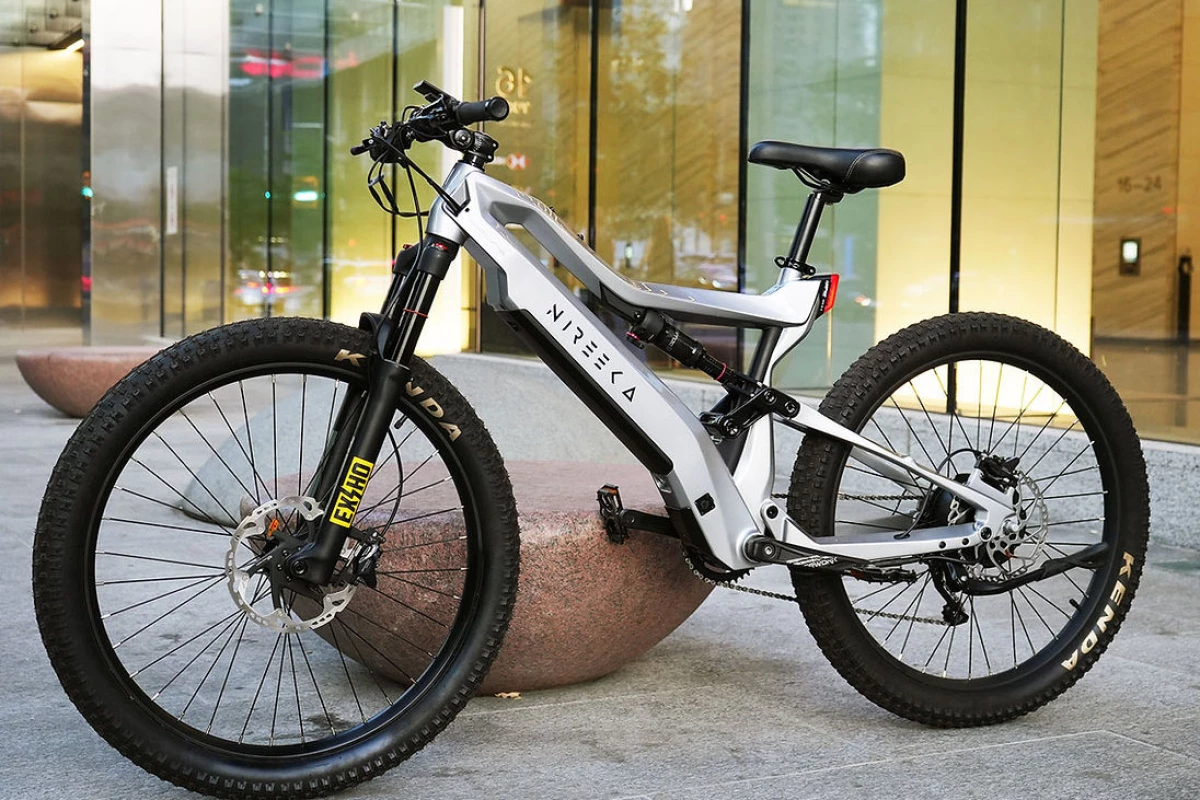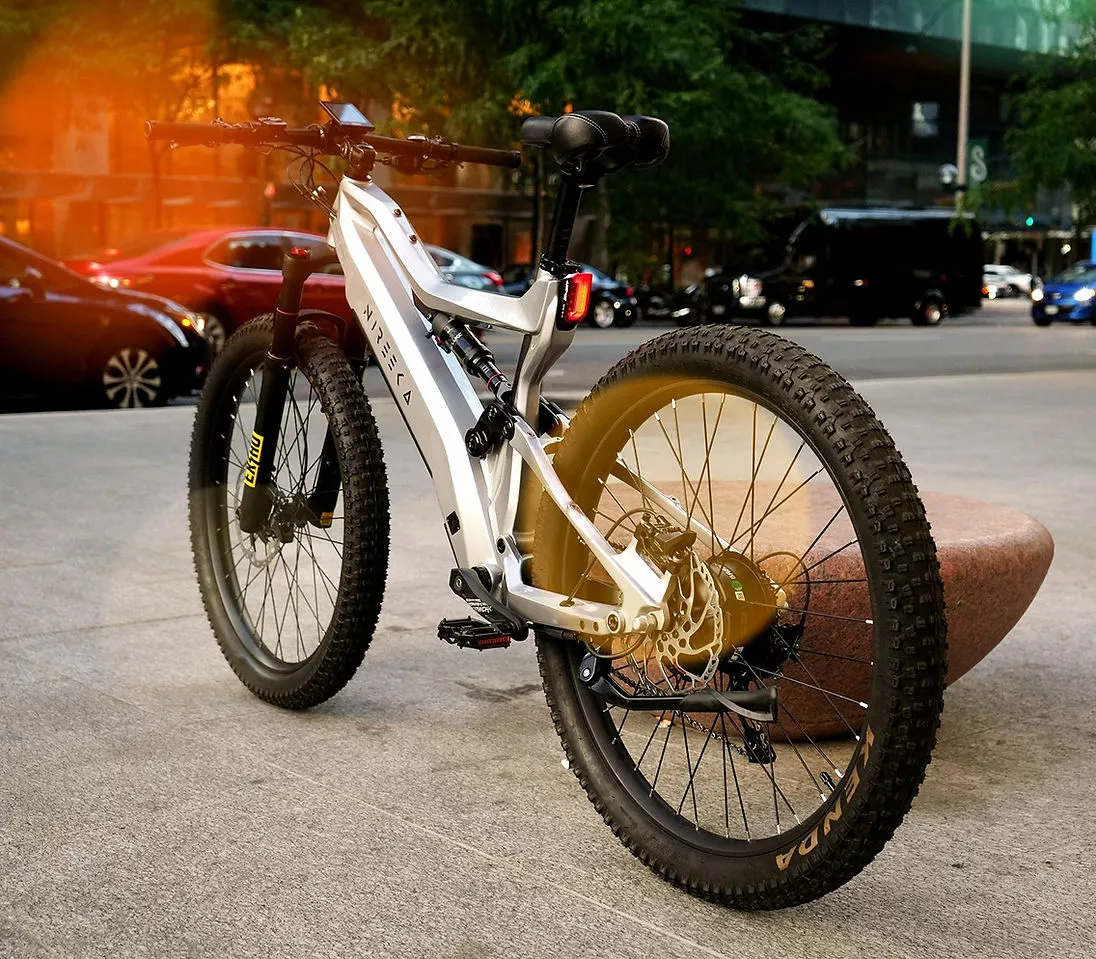Nireeka is back with another eye-popping (yet impressively affordable) carbon-framed ebike. The Revenant is a high-powered, dual-suspension, ABS-equipped commuter/mountain bike designed to replace the popular Homie, with added speed, range and refinement.
This is the fourth model from Nireeka founders Max and Younes Shojaie; after storming out of the gates with a ridiculous sub-US$1,000 deal on the Homie, Nireeka expanded on its futuristic design language with the Prime, a high-powered, mid-drive, hardtail cruiser that made some compromises, but delivered speed and sheer presence in formidable quantities. This was followed by the flagship Nyx, a mid-powered, mid-drive dual suspension machine focused on trail-riding.
But the price of the Nyx was starting to get up there among mainstream machines, so the company's returned to its more affordable roots for the new Revenant. Starting at around US$2,000 in early bird and VIP deals on Indiegogo, the Revenant isn't as cheap as the Homie, but it certainly looks like a step up, and while you can jump on Alibaba and match most of the specs for less, there's precious little at this price point that does the same things and looks this nice.

Like all the company's bikes, it's based around a beautifully designed carbon fiber frame. Similar in design to the Nyx trailbike, the Revenant is longer, with an angled shock, but it uses the same fascinating geometric shapes and it's fascinating to look at. It also packs in more electric power, and puts it in the back wheel rather than at the crank.
"So many customers that bought the Homie told us they wanted 1,000-W motors," co-founder and CEO Max Shojaie tells us over a video call, "but the dropouts weren't wide enough for the motors we wanted to use. Mid-drive motors make things expensive, and once you start using high-powered, high-torque motors, you start running into problems with the drivetrain – the chain, the cassette, the derailleur and everything, because the bicycle components just aren't ready for that power. We wanted the revenant to be affordable and to eliminate those problems, so we went for a hub drive, and we approached it with all the experience we've gained from the first three models."
So the Revenant uses a Bafang hub motor making up to 1,000 W and some 85 Nm (62.7 lb-ft) of torque. Putting the ~4-kg (8.8-lb) motor in the hub, says Shojaie, means the Revenant is not designed for heavy trail work or jumping – that's Nyx territory. But it means the drivetrain, a Shimano Alivio nine-speed system, only has to deal with force from the pedals, so chains and sprockets should last a lot longer. It's really only the spokes and tire that have to cop the brunt of the Revenant's full power when you mash the thumb throttle.

The top-option removable Samsung battery holds 840 Wh, which Nireeka says is good for around 85 km (50 miles) of range, depending of course on how you ride it. It'll charge in six hours on the standard charger. Standard, the bike runs on a cadence sensor that simply requires you to turn the pedals to engage the motor, but you can upgrade to a torque sensor if you want more of a natural and intuitive riding experience.
Keeping costs down, Nireeka has gone for an X-Fusion O2 air shock and its own custom-made fork, offering 140 mm (5.5 in) of travel at each end.
"The fork is not a famous brand, but the Revenant isn't about high end components," says Shojaie. "We've been working with this Taiwanese fork manufacturer for three years now, so we're sure about the quality, but the price isn't crazy like with Fox or Rockshox or some other brands."
With a top speed around 56 km/h (35 mph), and a weight around 24 kg (53 lb), traction and braking need to be taken seriously. Nireeka has gone for Shimano Diore hydraulic disc brakes with 180-mm rotors, complete with a brake light at the back. Kenda 27.5-inch mid-fat tires are your contact with the ground, 2.8 in wide at the front and 3 in at the back, with enough knobbiness for light off-roading.
Interestingly, the company has also decided to offer front-wheel ABS as a ~$300 option, through a Blubrake unit. This reduces total stopping distance, says Nireeka, while eliminating any worries about locking up the front wheel or braking yourself over the handlebars as the rear wheel comes up. The rear wheel is still free to skid.
The ABS system lives in a box mounted behind the rear fork leg, as you can see in the video above. I ask why?
"We could install the ABS inside the frame," says Shojaie, "but I wanted to keep it outside and make it a visible feature. It's not a common feature, we want it to be seen!
"We've taken in a lot of feedback from our customers over the last five years," he continues, "and requests, and problems, and it's all gone into the Revenant. I'm very proud of this design, I think it's perfect. We've had a good amount of time to test this bike, too, rather than rushing to return the investment. We've been riding it since February, and testing it for a few months now in Canada, and we feel sure about everything on this bike."

The Revenant is available for pre-order on Indiegogo now, with early bird deliveries slated for January and subsequent bikes due in February. Early bird "VIP" pricing starts at $1,999. Standard crowdfunding cautions apply.
Source: Nireeka Indiegogo











